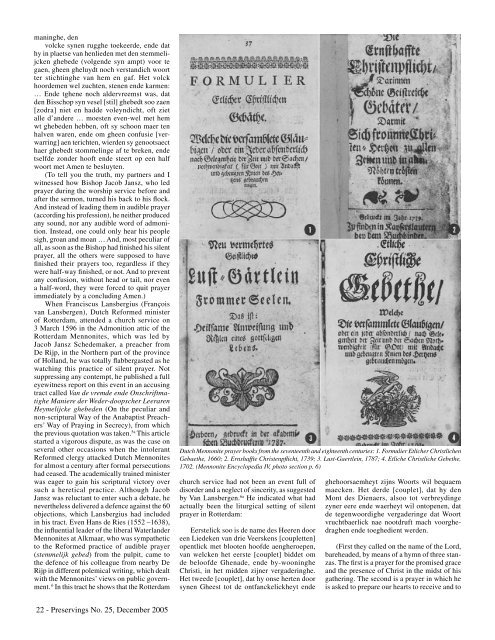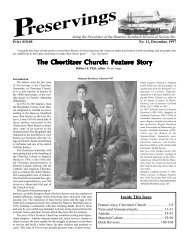Preservings $20 No. 25, December, 2005 - Plett Foundation
Preservings $20 No. 25, December, 2005 - Plett Foundation
Preservings $20 No. 25, December, 2005 - Plett Foundation
Create successful ePaper yourself
Turn your PDF publications into a flip-book with our unique Google optimized e-Paper software.
maninghe, den<br />
volcke synen rugghe toekeerde, ende dat<br />
hy in plaetse van henlieden met den stemmelijcken<br />
ghebede (volgende syn ampt) voor te<br />
gaen, gheen gheluydt noch verstandich woort<br />
ter stichtinghe van hem en gaf. Het volck<br />
hoordemen wel zuchten, stenen ende karmen:<br />
… Ende tghene noch aldervreemst was, dat<br />
den Bisschop syn vesel [stil] ghebedt soo zaen<br />
[zodra] niet en hadde voleyndicht, oft ziet<br />
alle d’andere … moesten even-wel met hem<br />
wt ghebeden hebben, oft sy schoon maer ten<br />
halven waren, ende om gheen confusie [verwarring]<br />
aen terichten, wierden sy genootsaect<br />
haer ghebedt stommelinge af te breken, ende<br />
tselfde zonder hooft ende steert op een half<br />
woort met Amen te besluyten.<br />
(To tell you the truth, my partners and I<br />
witnessed how Bishop Jacob Jansz, who led<br />
prayer during the worship service before and<br />
after the sermon, turned his back to his flock.<br />
And instead of leading them in audible prayer<br />
(according his profession), he neither produced<br />
any sound, nor any audible word of admonition.<br />
Instead, one could only hear his people<br />
sigh, groan and moan … And, most peculiar of<br />
all, as soon as the Bishop had finished his silent<br />
prayer, all the others were supposed to have<br />
finished their prayers too, regardless if they<br />
were half-way finished, or not. And to prevent<br />
any confusion, without head or tail, nor even<br />
a half-word, they were forced to quit prayer<br />
immediately by a concluding Amen.)<br />
When Franciscus Lansbergius (François<br />
van Lansbergen), Dutch Reformed minister<br />
of Rotterdam, attended a church service on<br />
3 March 1596 in the Admonition attic of the<br />
Rotterdam Mennonites, which was led by<br />
Jacob Jansz Schedemaker, a preacher from<br />
De Rijp, in the <strong>No</strong>rthern part of the province<br />
of Holland, he was totally flabbergasted as he<br />
watching this practice of silent prayer. <strong>No</strong>t<br />
suppressing any contempt, he published a full<br />
eyewitness report on this event in an accusing<br />
tract called Van de vremde ende Onschriftmatighe<br />
Maniere der Weder-doopscher Leeraren<br />
Heymelijcke ghebeden (On the peculiar and<br />
non-scriptural Way of the Anabaptist Preachers’<br />
Way of Praying in Secrecy), from which<br />
the previous quotation was taken. 5a This article<br />
started a vigorous dispute, as was the case on<br />
several other occasions when the intolerant<br />
Reformed clergy attacked Dutch Mennonites<br />
for almost a century after formal persecutions<br />
had ceased. The academically trained minister<br />
was eager to gain his scriptural victory over<br />
such a heretical practice. Although Jacob<br />
Jansz was reluctant to enter such a debate, he<br />
nevertheless delivered a defence against the 60<br />
objections, which Lansbergius had included<br />
in his tract. Even Hans de Ries (1552 –1638),<br />
the influential leader of the liberal Waterlander<br />
Mennonites at Alkmaar, who was sympathetic<br />
to the Reformed practice of audible prayer<br />
(stemmelijk gebed) from the pulpit, came to<br />
the defence of his colleague from nearby De<br />
Rijp in different polemical writing, which dealt<br />
with the Mennonites’ views on public government.<br />
6 In this tract he shows that the Rotterdam<br />
22 - <strong>Preservings</strong> <strong>No</strong>. <strong>25</strong>, <strong>December</strong> <strong>2005</strong><br />
Dutch Mennonite prayer books from the seventeenth and eighteenth centuries: 1. Formulier Etlicher Christlichen<br />
Gebaethe, 1660; 2. Ernshaffte Christenpflicht, 1739; 3. Lust-Gaertlein, 1787; 4. Etliche Christliche Gebethe,<br />
1702. (Mennonite Encyclopedia IV, photo section p. 6)<br />
church service had not been an event full of<br />
disorder and a neglect of sincerity, as suggested<br />
by Van Lansbergen. 6a He indicated what had<br />
actually been the liturgical setting of silent<br />
prayer in Rotterdam:<br />
Eerstelick soo is de name des Heeren door<br />
een Liedeken van drie Veerskens [coupletten]<br />
opentlick met blooten hoofde aengheroepen,<br />
van welcken het eerste [couplet] biddet om<br />
de beloofde Ghenade, ende by-wooninghe<br />
Christi, in het midden zijner vergaderinghe.<br />
Het tweede [couplet], dat hy onse herten door<br />
synen Gheest tot de ontfanckelickheyt ende<br />
ghehoorsaemheyt zijns Woorts wil bequaem<br />
maecken. Het derde [couplet], dat hy den<br />
Mont des Dienaers, alsoo tot verbreydinge<br />
zyner eere ende waerheyt wil ontopenen, dat<br />
de tegenwoordighe vergaderinge dat Woort<br />
vruchtbaerlick nae nootdruft mach voorghedraghen<br />
ende toeghedient werden.<br />
(First they called on the name of the Lord,<br />
bareheaded, by means of a hymn of three stanzas.<br />
The first is a prayer for the promised grace<br />
and the presence of Christ in the midst of his<br />
gathering. The second is a prayer in which he<br />
is asked to prepare our hearts to receive and to

















